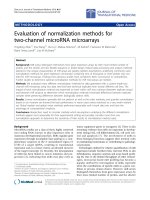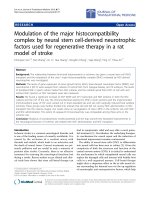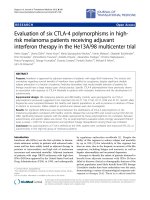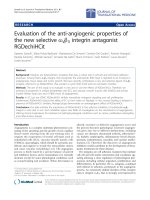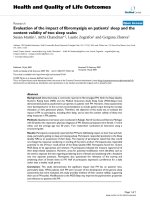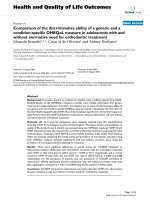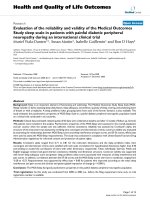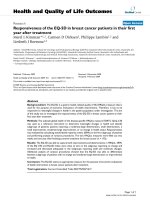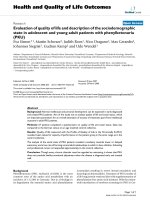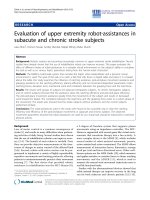báo cáo hóa học: " Evaluation of methods for extraction of the volitional EMG in dynamic hybrid muscle activation" pot
Bạn đang xem bản rút gọn của tài liệu. Xem và tải ngay bản đầy đủ của tài liệu tại đây (321.96 KB, 11 trang )
BioMed Central
Page 1 of 11
(page number not for citation purposes)
Journal of NeuroEngineering and
Rehabilitation
Open Access
Research
Evaluation of methods for extraction of the volitional EMG in
dynamic hybrid muscle activation
Eran Langzam
1
, Eli Isakov*
2
and Joseph Mizrahi
1
Address:
1
Department of Biomedical Engineering – Technion, Israel Institute of Technology, Haifa, Israel and
2
Loewenstein Rehabilitation Center,
Raanana, Israel
Email: Eran Langzam - ; Eli Isakov* - ; Joseph Mizrahi -
* Corresponding author
Abstract
Background: Hybrid muscle activation is a modality used for muscle force enhancement, in which
muscle contraction is generated from two different excitation sources: volitional and external, by
means of electrical stimulation (ES). Under hybrid activation, the overall EMG signal is the
combination of the volitional and ES-induced components. In this study, we developed a
computational scheme to extract the volitional EMG envelope from the overall dynamic EMG
signal, to serve as an input signal for control purposes, and for evaluation of muscle forces.
Methods: A "synthetic" database was created from in-vivo experiments on the Tibialis Anterior of
the right foot to emulate hybrid EMG signals, including the volitional and induced components. The
database was used to evaluate the results obtained from six signal processing schemes, including
seven different modules for filtration, rectification and ES component removal. The schemes
differed from each other by their module combinations, as follows: blocking window only, comb
filter only, blocking window and comb filter, blocking window and peak envelope, comb filter and
peak envelope and, finally, blocking window, comb filter and peak envelope.
Results and conclusion: The results showed that the scheme including all the modules led to an
excellent approximation of the volitional EMG envelope, as extracted from the hybrid signal, and
underlined the importance of the artifact blocking window module in the process.
The results of this work have direct implications on the development of hybrid muscle activation
rehabilitation systems for the enhancement of weakened muscles.
Background
Electromyography (EMG) is an important tool in the
fields of biomechanics and kinesiology. In the time
domain, the envelope of the rectified EMG signal is com-
monly used for several applications including: force esti-
mator [1], muscle activity indicator [2], fatigue indicator
[3], and more recently as a bio-control signal (e.g: [4-9]).
The term Hybrid muscle activation, coined by the present
authors [10,11] is a modality where muscle contraction is
generated from two different excitation sources, volitional
and external electrical stimulation (ES). This modality has
been described in previous works, usually for the
enhancement of deficient muscles [5,6,8,11-14]. In
hybrid activation, the overall EMG signal is the combina-
tion of the volitional and the induced components.
Published: 23 November 2006
Journal of NeuroEngineering and Rehabilitation 2006, 3:27 doi:10.1186/1743-0003-3-27
Received: 30 January 2006
Accepted: 23 November 2006
This article is available from: />© 2006 Langzam et al; licensee BioMed Central Ltd.
This is an Open Access article distributed under the terms of the Creative Commons Attribution License ( />),
which permits unrestricted use, distribution, and reproduction in any medium, provided the original work is properly cited.
Journal of NeuroEngineering and Rehabilitation 2006, 3:27 />Page 2 of 11
(page number not for citation purposes)
A typical muscle response to ES includes the stimulus arti-
fact, in the form of a spike which immediately follows the
electrical stimulus; and an M-wave response which
appears afterwards. Due to the fact that the spike's major
effect lasts just a few milliseconds, it can be eliminated by
using various methods, such as time-windowing [15]. On
the other-hand, the M-wave response spreads over most of
the inter-pulse time and has a characteristic and repetitive
general shape whose specific features depend on factors
such as stimulus intensity, shape and polarity.
Current knowledge on the mode of interaction between
the volitional and the ES components of the EMG is
ambiguous. Early works assumed that in the hybrid EMG
signal those two components are simply added up, reflect-
ing the muscle electrical activity when volitional and ES
activations take place simultaneously [12]. Recently, how-
ever, we were able to show that this assumption is not
accurate [10,11].
Extraction of the volitional component from the overall
EMG signal thus requires the elimination of the ES com-
ponent. This is feasible by using hardware and/or software
techniques.
Hardware solutions were suggested to suppress the stimu-
lus artifact by using a signal blocking window [4-6,8,11-
19]. Software solutions were used for both stimulus arti-
fact and M-wave elimination [6-8,12,20-23] and were
achieved by a variety of signal processing filters, including
the comb-filter [6,12], wavelets [22,23], adaptive filters
[16], or Gram-Schmidt filters [7].
Despite the many methods for the elimination of the ES-
induced component, providing the volitional only EMG
component, most of them do not provide an evaluation
of the accuracy of the extraction procedure i.e., how well
the procedure resolves a hybrid signal into its compo-
nents. The few reports that did so, based their evaluation
on steady muscle contraction analysis, and involved
mathematical procedures that are difficult to implement
[7,16].
In this paper we compare methods for the accurate extrac-
tion of the volitional EMG envelope out of the raw
dynamic EMG signal. A synthesized, well-defined and
known EMG signal, served for the development and vali-
dation of the preferred method. Hybrid activation of the
muscle was represented by the combined contributions of
the volitional and ES induced muscle contractions under
dynamic conditions of muscle activation, simulating in
vivo gait-like contractions of the Tibialis Anterior (TA)
muscle. The method of choice was reached by comparing
the scoring results from several processing algorithms.
Methodology
Experimental procedure
Subjects
Five subjects (see details in Table 1) participated in the
study. The subjects had an average (SD) age of 28.6 (5.4)
years, height of 1.77 (0.13) m, and mass of 66.2 (12.7) kg.
All subjects were in an excellent state of health, with no
history of muscle weakness, neurological disease or drug
therapy. The experiment was approved by the local ethical
committee and each subject provided informal consent
according to the local ethical committee's guidelines.
EMG & mechanical measurements
On-line readings of the ankle torque and EMG of the right
TA muscle were taken during each of the experimental tri-
als. The isometric torque was monitored in the seated
position by means of a load cell connected on one side to
a holding fixture and on the other side to a plate which
served as a foot rest and to which the foot was strapped
(Fig. 1). The torque due to gravitation was compensated
for from the load cell readings while the foot rested on the
plate. At this stage, the subject was instructed to relax his
leg muscles. Relaxation was confirmed from the unno-
ticed EMG signal obtained from the monitored muscles.
During the test, the ankle, knee and hip angles were set at
90°.
EMG was monitored using three surface SKINTACT
®
Ag-
AgCl circular electrodes (contact diameter of 1.5 cm, exter-
nal diameter of 5 cm): two active electrodes were located
on the muscle belly along its longitudinal axis at mid-dis-
tance between the ES stimulation electrodes (see below),
Table 1: Details of the subjects taking part in this study and their respective testing protocol parameters
Subject Sex Age [years] Height [m] Mass [Kg] Volitional Torque levels [%MVC] ES intensities [mAmp]
1 M 33 1.95 83.0 5, 10, 15, 20, 25 3, 5, 7, 10, 12, 15, 20
2 M 35 1.70 60.0 5, 10, 15, 20, 25 3, 5, 7, 10, 12, 15
3 F 25 1.62 51.0 5, 10, 15, 20, 25 3, 5, 7, 10, 12
4 M 22 1.84 75.0 5, 10, 15, 20, 25 3, 5, 7, 10, 12, 15
5 M 28 1.75 62.0 5, 10, 15, 20, 25 3, 5, 7, 10, 12, 15, 20
Avg. 28.6 (5.4) 1.77 (0.13) 66.2 (12.7)
Journal of NeuroEngineering and Rehabilitation 2006, 3:27 />Page 3 of 11
(page number not for citation purposes)
the distance between the electrodes was 6 cm center-to
center [5,12,15]. The third electrode was a ground elec-
trode and was placed on the bony medial epicondyle area
of the knee femur. Before attachment of the electrodes the
skin surface was cleaned and rubbed until the electrical
impedance between each pair of electrodes was smaller
than 5 KΩ. The three electrodes were connected to a spe-
cially designed 10 kHz bandwidth DC amplifier with
stimulus artifact suppression [15].
The artifact suppressor [15] consists of a sample-and-hold
amplifier. The amplifier board is designed to synchronize
with the stimulation pulses and to hold the output for a
period of 2 milliseconds from the stimulation-pulse
onset.
The torque and EMG signals were sampled at a sampling
rate of 1 KHz.
Transcutaneous stimulation was delivered to the muscle
using two surface rectangular electrodes (5 × 5 cm): one
placed over the TA motor point, and the second, 20 cm
distally to the first one (center-to-center). The stimulation
parameters were controlled through a PC.
Experimental set-up used for data acquisitionFigure 1
Experimental set-up used for data acquisition.
Electrical
Stimulation
ON
OFF
Automatic
Trigger
Artifact
Suppresso
r
Subject
Screen
Signal conditioning
EMG elec.
FES elec.
Load cell
Examiner
Screen
Data acquisition PC
Journal of NeuroEngineering and Rehabilitation 2006, 3:27 />Page 4 of 11
(page number not for citation purposes)
Both electrode-sets distances were slightly modified (if
necessary), to obtain an overall optimal performance of
both EMG, and ES system.
MVC measurement
Before any experimental activity, measurement of the
Maximum Voluntary Contraction (MVC) was carried out.
The subject was asked to maximally and isometrically
contract his right TA muscle for 5 s. A time window of 0.5
s from the maximal contraction plateau was taken to cal-
culate the mean torque and mean envelope of the rectified
EMG signals. Three trials were made, with 5 min of resting
time between them, and the average was taken to repre-
sent MVC for normalization of the torque and EMG.
Volitional torque/EMG signals
For the acquisition of the volitional EMG signals the sub-
jects were requested to volitionally track a visually dis-
played torque-time profile by isometrically activating the
Tibialis Anterior (TA) muscle through the application of a
dorsi-flexion torque at the ankle. The general features of
the target torque (T
target
), mimic the TA torque activity
observed during the late swing phase of human gait (Fig.
2) [24]; inability to provide this torque is directly related
to biomechanical problems such as drop foot.
The session included 5 trials, each of 15 s duration, with
five min interval time between them for resting. The trials
differed from each other by their amplitudes, which were
varied between 0.05 to 0.25 MVC, at increasing steps of
0.05 MVC, and providing altogether five levels of voli-
tional activity. The 0.25 MVC limit was chosen because
this is the typical range of the TA volitional torque during
swing [2]. Table 1 describes the specific volitional torques
levels for each subject.
Target torque (solid line) and ES profile (dash-dot line, ON/OFF modes) used to synthesize the EMG databaseFigure 2
Target torque (solid line) and ES profile (dash-dot line, ON/OFF modes) used to synthesize the EMG database. The target
torque amplitude varied from 0.05 to 0.25 MVC.
Journal of NeuroEngineering and Rehabilitation 2006, 3:27 />Page 5 of 11
(page number not for citation purposes)
Induced EMG signals
For acquisition of the EMG signals from the electrically
induced contractions, the subject was instructed to stop
any volitional activation while his muscle was subjected
to the dynamic stimulation profile depicted in Fig. 2. Jus-
tification of this profile is based on the role of ES, which
was intended to serve for enhancement of the volitional
activation [11]. Thus it was necessary to set the ES signal
in concert with the target torque signal from the following
aspects: (a) duration of the ES signal; (b) synchronization
between the two signals. ES was applied by a constant cur-
rent, electrical stimulator providing 0.3 sec stimulation
trains with mono-phasic rectangular pulses of 100 μs
duration, and frequency of 20 Hz [25].
An automatic operation signal was used to dynamically
turn the stimulator on and off. The ES activation session
was performed five min after completion of the volitional
session. The trials differed from one another by the stim-
ulation intensity, which was set to cover induced torque
amplitudes, ranging between 0.05 to 0.15 MVC; the 0.15
MVC limitation was determined as the highest intensity in
which the subjects felt comfortable. For the subjects tak-
ing part in this study 5 trials or more were necessary to
cover this range. Also here, the time length of each trial
was 15 s and the resting time between successive trials was
5 min. Table 1 describes the ES intensities that were used
to stimulate each subject.
EMG database
A database of the EMG signal was set to gain information
on the partition between the volitional and ES-induced
components in the overall EMG signal. The database was
produced from in-vivo experimental data. A basic signal in
the database was the simple summation of the EMG sig-
nals that were acquired from volitional excitation only
and ES-excitation only muscle tests. The entire database
normally included 25 or more synthesized EMG signals,
which covered the above described combinations voli-
tional and ES trials.
Processing of the EMG signal
Several processing schemes of the EMG signal were used
to extract the volitional EMG envelope from the raw EMG
signal, which included both of the volitional and the ES
components. Each scheme comprised several stages,
which can be divided into two block groups: rigid blocks
whose inclusions are mandatory in the scheme, and flexi-
ble blocks, whose inclusions in the scheme are optional.
The effect of the flexible blocks was tested by their progres-
sive inclusion into the processing scheme.
The complete processing scheme thus included the fol-
lowing steps (Fig. 3):
(a) The raw EMG was high-passed filtered (Butterworth
HPF, order 4, cutoff frequency 15 Hz);
(b) For the ES-induced signal only, ES artifacts were
removed from the EMG using a blocking window of 25
ms. The blocking window started at a beginning of the
stimulus artifact pulse and ended 25 msec later [12]:
EMG(t
stimulus
) = 0, EMG(t
stimulus
+ 1 msec) = 0, , EMG(t
stimu-
lus
+ 25 msec) = 0
(c) Comb-filter was used [12] to retain the volitional only
component of the signal:
Where x(n) is the n
th
sample of the actual EMG signal,
N
stim
is the stimulus duration expressed in number of sam-
ples and y(n) is the filtered EMG signal.
(d) The volitional EMG was rectified: EMG
Rectified_i
=
abs(EMG
volitional_i
)
(e) The signal envelope was obtained by connecting the
rectified signal peaks by straight lines.
(f) The envelope was low-pass filtered, introducing a
smooth envelope profile (Butterworth LPF, order 4, cutoff
frequency 5 Hz), and
(g) The smoothed envelope was normalized to EMG
MVC
,
as previously defined: EMG
Normalized
= EMG
envelope
/EMG
MVC
.
The "rigid" modules thus included steps (a), (d), (f), and
(g); and the "flexible" modules included steps (b), (c),
and (e). Six different schemes, covering all possible com-
binations of "flexible" modules inclusion into the proc-
ess, were tested.
Error analysis and statistics
Error analyses were performed to compare the volitional
EMG envelopes, as obtained after extraction from the syn-
thesized data to those obtained directly from the voli-
tional signal. The global error was expressed by the Root
Mean Square Error (RMSE), as follows:
where: N is the number of samples, CVEMG
i
is the i-th
sample of the Calculated Volitional EMG (as obtained
from the hybrid signal), MVEMG
i
is the i-th sample of the
Measured Volitional EMG (as obtained from the database
nominal signal), and PeakAmp
MVEMG
is the mean peak
amplitude of the measured EMG.
yn
xn xn N
Stim
()
() ( )
=
−−
()
2
1
RMSE
N
CVEMG MVEMG
PeakAmp
ii
N
MVEMG
=−⋅
()
∑
1 100
2
2
1
()
Journal of NeuroEngineering and Rehabilitation 2006, 3:27 />Page 6 of 11
(page number not for citation purposes)
A Processing scheme of the EMG signalFigure 3
A Processing scheme of the EMG signal. The grey blocks designate "Rigid" processing modules and their inclusion was manda-
tory in the scheme. The white blocks designate "Flexible" processing modules whose inclusions in the scheme are optional, and
they were inserted into and out of the process in various combinations. * Butterworth, 4
th
order, with cut-offfrequency of 15
Hz. ** Butterworth, 4
th
order, with cut-off frequency of 5 Hz.
Volitional only
EMG
High pass filter*
Blocking window
(25msec)
Comb filter
Rectification
Peak envelope
Low pass filter**
Induced only
EMG
Synthesized
database
Normalization by
EMG at MVC
EMG ENVELOPE
Comb filter
Rectification
Peak envelope
Low pass filter**
High pass filter*
Normalization by
EMG at MVC
EMG ENVELOPE
Comparison Parameters:
- Global: Root Mean Square Error (RMSE)
- Local: Mean Amplitude Error (MAE)
+
-
Journal of NeuroEngineering and Rehabilitation 2006, 3:27 />Page 7 of 11
(page number not for citation purposes)
This definition enabled a comparative analysis of errors,
without being affected by their changing amplitudes.
The local error was expressed by the Mean Amplitude
Error (MAE), defined as:
Where: k is the gait cycle number, PeakAMP
CVEMG_K
is the
peak amplitude of the Calculated Volitional EMG in cycle
k, and PeakAMP
MVEG_K
is the peak amplitude of the Meas-
ured Volitional EMG in cycle k.
Both RMSE and MAE were calculated for each of the data-
base files using all the EMG processing schemes. ANOVA
statistics (α < 0.05) were used to determine statistical dif-
ferences in the schemes' RMSE and MAE values.
Results
Figure 4 illustrates typical volitional EMG envelopes that
resulted from processing the synthesized signal, using
three different processing schemes. The naked eye inspec-
tion reveals that the processing scheme including comb-
filtering and artifact blocking window gave the closest
result to the original volitional EMG signal. Tables 2 and
3 summarize the results of the RMSE and MAE values of
the tested subjects and for the implemented processing
schemes. The results indicate that the complete process,
which included all blocks, consistently yielded low mean
RMSE and MAE values compared to the other tested proc-
esses.
The RMSE values for the complete processing scheme, i.e.,
including all three "flexible" blocks, ranged between
1.21(0.87) and 3.85(3.32), lower compared to every
other tested processing scheme. The highest RMSE errors
were observed in those processes that did not include the
Artifact Blocking Window module and their value ranged
between 9.55(7.25) and 31.57(17.91). This points out to
the importance of that module for the successful compu-
tation of the volitional EMG.
The MAE analyses results were not so conclusive. In 4 out
of 5 subjects, the complete processing scheme yielded
lower values, between 7.69(6.10) and 17.98(15.72), com-
pared to every other tested processing scheme. In 3 sub-
jects that decrease was significant. In one subject the
process which included only two out of three "flexible"
blocks, i.e., peak envelope and artifact blocking window,
yielded lower (= 7.94) MAE values, compared to the com-
plete process results (8.13). However, this difference was
not significant. Similar to the RMSE indication, the MAE
values also revealed high errors in processing schemes that
did not include the artifact blocking window, with values
ranging between 34.51(24.72) to 185.06(118.35)), thus
providing further indication to the importance of this
block.
Discussion
The EMG signal provides useful information about the
muscle force developed under volitional muscle contrac-
tion. In the time domain, the rectified EMG envelope has
been widely used for various applications, ranging from
simple On/Off activation trigger [9] to muscle force esti-
mation (e.g. [1,26,27]).
In cases of hybrid activation, i.e., when ES is being used to
augment volitional muscle activation, the rectified EMG
can be used either as a control signal [4-6,14,16], or as a
muscle force estimator [11]. In this mode of activation the
volitional and ES-induced components of the EMG mix
up together, and extraction of the volitional component
from the raw EMG signal is required for monitoring and
control purposes, necessitating multi-step processing pro-
cedures. Methods to extract the volitional component out
of the raw EMG signal during hybrid activation have been
developed (e.g., [6,12,16]). Few of these reports validate
the success in extracting the volitional EMG. To accom-
plish that, the hybrid EMG signal was emulated by adding
up together its volitional and induced components [7,16].
In these latter studies muscle was under static contraction
and the EMG signals were represented mathematically
(i.e., by an explicit mathematical equation); thus the
extraction process necessitated complex processing proce-
dures such as filtration with adaptive filters [16], or Gram-
Schmidt prediction error filters [7].
Several methods were used for evaluation of the success of
extraction of the volitional EMG. The basic one was by vis-
ual inspection of the approximated signal which, despite
not providing information on the processing method
accuracy, can tell if the signal can be successfully utilized
for control purposes [4-6,9,14].
More advanced methods utilized mathematical parame-
ters to score the processing success. Yoem et al. [7] used
three evaluation criteria: (a) visual inspection of the
power spectra of the signals; (b) comparison of the sig-
nals' RMS values; and (c) 'false-positive' parameter that
calculated the number of times in which the extracted sig-
nal peak amplitude is higher than the maximum value of
the pure original EMG ingredient. The obtained parame-
ters' values, which indicated: good visual matching, RMS
value close to 1, and small 'false-positive' value, enabled
the authors to conclude that a 6
th
order Gram-Schmidt
prediction error filter successfully preserves the original
volitional EMG signal.
MAE
mean abs PeakAMP PeakAMP
mean PeakAMP
CVEMG k MVEMG k
CV
=
−(( ))
(
__
EEMG k_
)
⋅
()
100 3
Journal of NeuroEngineering and Rehabilitation 2006, 3:27 />Page 8 of 11
(page number not for citation purposes)
Sennels et al. [16] illustrated various quantitative tools to
test several configurations of adaptive filters. They
showed, that for simulated data the adaptive filters they
used were relatively insensitive to variations in the muscle
responses; however for real-data, it was better to use adap-
tive filter with a large number of elements. Their results
led them to the conclusion that a 6-element adaptive filer
can successfully eliminate the ES share from the hybrid
EMG signal.
The methodology developed in the present study was dif-
ferent in two respects: (a) each of the activation compo-
nents was the result of dynamic, rather than static
contraction, and (b) the signals were represented numeri-
cally, by means of their sampled actual values, obtained
from repetitive dynamic contraction data simulating typi-
cal gait-like activity of the TA muscle during a swing
phase. The advantage of this approach is that it better
reflects real-life situation, whereby signals are normally
dynamic, rather than static and they may not always be
represented mathematically.
Additionally, since we were interested in the EMG enve-
lope of the volitional component rather than in its raw
signal, the resulting processing scheme turned to be much
simpler than the one developed in the abovementioned
previous works. This concept is different from other
works, in which it is first attempted to obtain the raw voli-
tional signal, and then apply standard processing routines
to derive its envelope [4-6,8,12,16,20]. The idea here is
that since the envelope pattern is smoother and well-
defined compared to the raw EMG, it can be recovered
more accurately and with less complexity, compared to
the traditional methods. Those advantages are of great rel-
An Illustration of typical volitional EMG envelopes that resulted from processing the synthesized signal, using three different processing schemesFigure 4
An Illustration of typical volitional EMG envelopes that resulted from processing the synthesized signal, using three different
processing schemes. Index: WF – with comb-filter filtering, WOF – without comb-filter filtering, WAR – with artifact suppres-
sor by a blocking time-window, WOAR – without artifact suppressor by a blocking time-window
Journal of NeuroEngineering and Rehabilitation 2006, 3:27 />Page 9 of 11
(page number not for citation purposes)
evance when using the procedure for real-time applica-
tions.
Basically, the signal processing scheme relies on com-
monly used routines, involving 'rigid' and 'flexible' mod-
ules. The 'rigid' modules, which include high-pass
filtration, signal rectification, and low-pass filtration, are
commonly used for EMG envelope calculations (e.g.:
[1,20]); and the 'flexible' modules are commonly found
in the context of ES artifacts removal [6,12,15,17,21]. The
role of each module in the process is well defined: The
"Artifact Blocking Window" module suppresses the ES
artifact (e.g.: [6,12], [15]). The Comb-filter filtration mod-
ule further cleans the signal from the ES component [12].
The Rectified signal peak envelope module provides a
rough representation of the EMG envelope, and recon-
structs its pattern in regions where the signal has been
chopped out for artifact suppression (e.g., in the blocked
regions). A processing scheme that combines together
these modules is not found in literature.
Several works dealt with the ES artifact with utilization of
only one of the above modules; mostly Comb-filter filtra-
tion or Artifact Blocking Window [12,20,21]. Frigo et al.
[12] have used both Comb-filter filtration and Artifact
Blocking Window modules, and reported on improved
elimination of ES component.
Our work has shown that all three 'flexible' modules are
necessary for the appropriate elimination of the ES com-
ponent from the overall signal. However, when only the
Comb-filter or Artifact Blocking Window module takes
part in the process, we demonstrated that inclusion of the
Rectified peak envelope module was not necessary and
could introduce substantial errors. This is because the Rec-
tified Peak Envelope module is only effective when the
signal is completely cleaned from its ES component.
When the Comb-filter filtration and Artifact Blocking
Window were joined together in the process, the rectified
signal did not have any substantial ES remainders and the
envelope reconstruction was successful. However, when
only one of the above modules was used, there were still
some ES residuals [12] that led to an erroneous envelope
reconstruction.
It should be noted, though, that in the Rectified signal
peak envelope module, a complete period of the signal is
required in order to reconstruct its blocked regions. This
introduces a time delay of one period, thus preventing
real-time application of the Rectified signal peaks enve-
Table 2: Summary of the Normalized Root Mean Square Error (NRMSE) values of the tested subjects for the implemented processing
schemes
Processing Module (s) normalized RMSE of EMG (NRMSE) [%]
Peaks
envelope
Comb filter Artifact
blocking
1 (n = 35) 2 (n = 30) 3 (n = 30) 4 (n = 30) 5 (n = 30) Mean
- - 5.35 (2.76) 11.12 (2.65) 8.30 (4.08) 10.37 (3.40) 7.78 (6.13) 8.58
- - 15.28 (8.12) 9.55 (7.25) 24.18 (11.42) 12.76 (4.94) 29.89 (16.31) 18.33
- 9.51(2.28) 15.74 (1.26) 10.75 (4.57) 13.52 (2.59) 9.61 (3.98) 11.82
- 7.78 (3.58) 7.75 (5.99) 7.89 (4.52) 8.84 (5.49) 32.66 (17.91) 12.98
- 18.02 (9.85) 10.52 (7.15) 28.65 (14.69) 14.97 (5.29) 31.57 (17.91) 20.74
* 1.21(0.87) * 3.05 (1.54) * 2.96 (2.56) * 1.80 (1.21) * 3.85 (3.32) 2.57
* Significantly lower than all items in same column (α < 0.05)
Table 3: Summary of the Mean Amplitude Error (MAE) values of the tested subjects for the implemented processing schemes
Processing Module (s) Mean Amplitude Error (MAE) [%]
Peaks envelope Comb filter Artifact
blocking
1 (n = 35) 2 (n = 30) 3 (n = 30) 4 (n = 30) 5 (n = 30)
- - 64.81 (8.71) 41.25 (5.98) 33.48 (14.10) 51.97 (6.92) 30.16 (14.31)
- - 49.96 (54.23) 39.63 (34.21) 128.09 (75.66) 34.51 (24.72) 161.78 (107.28)
- 66.20 (7.64) 43.97 (6.84) 32.15 (12.59) 56.02 (7.23) 41.47 (12.56)
- 7.94 (7.42) 28.32 (19.78) 34.51 (25.12) 31.05 (14.40) 96.43 (47.88)
- 73.54 (37.44) 48.11 (37.73) 185.06 (118.35) 52.77 (27.82) 177.77 (104.31)
8.13 (6.18) * 7.69 (6.10) 17.98 (15.72) * 7.58 (5.64) * 10.46 (8.21)
* Significantly lower than all items in same column (α < 0.05)
Journal of NeuroEngineering and Rehabilitation 2006, 3:27 />Page 10 of 11
(page number not for citation purposes)
lope module. For real-time applications, the literature has
suggested several solutions to emulate the operation of
this module, the most common being a blocking window
with an average signal value, or a holder that retains the
pre-blocking last sample value of the signal [8,20,21].
This allows for the reconstruction of the missing samples,
thus providing its real-time envelope approximation.
To compare between the calculated volitional EMG-enve-
lope (i.e., from synthetic database) and the actual one
(from volitional only tests), we used two parameters,
RMSE and MAE, for the large and small scale compari-
sons, respectively.
The RMSE expresses the mean difference between two sig-
nals, and reflects their general similarity. This parameter is
widely used in literature (e.g: [7,22]).
The MAE parameter expresses the difference between the
approximated and actual signal amplitudes. Assuming
that the signals do not have any difference in phase and
shape, the difference in amplitudes represents the local
error. Since many applications use the value of the EMG
envelope as a control signal [4-6,8,12], MAE becomes
important and knowledge of the envelope approximation
error is required for system design. A similar MAE analysis
is not found in literature, probably since all the related
works dealt with recovery of the raw volitional-EMG sig-
nal and not of its envelope (e.g., [7,20,21,23]).
The suggested method in our work provides rational eval-
uators for the performance of the various schemas. These,
however, are not the only possible evaluators. For
instance, Sennels et al [16] used other evaluators to test
the success of their methods. The first evaluator was used
on simulated data, and examined the ratio between the
input signal to noise ratio (SNR) and the output SNR; the
second evaluator was used on real-data, and examined the
power reduction of the input and output signals. Thus,
further works should enable unbiased comparisons
between current and earlier works.
It is noticeable that the variance of the MAE, and RMSE
values between the subjects was high. Several reasons can
lead to such behavior; e.g.: differences in anatomy, tissue
structure, muscle fatigue, etc., which have an effect on the
subject's ES pattern, and therefore on the schema perform-
ance. Nevertheless, for the selected schema, the obtained
low values of RMSE and MAE (RMSE: 1.21 – 3.85%, MAE:
7.58 – 10.46%) in all the subjects but one, indicate the
high accuracy of the processing method, and point out
that the preferred computational scheme should include
all modules.
A major assumption was made in this work, according to
which the hybrid EMG can be represented by the superpo-
sition of the volitional only and induced only EMG sig-
nals. This assumption relied on a preliminary work, which
verified that a superimposed signal has the characteristics
of an actual hybrid signal; thus, the superimposed hybrid
signal has a typical spike and M-wave which can be related
to the ES component, together with a stochastic-like signal
resulting from the volitional component. In addition,
since the origins of the superimposed signal are known,
we can establish an unbiased comparison between the
various signal-processing schemes and their ability to sat-
isfactorily resolve the hybrid signal into its components.
When a preferred signal-processing scheme is obtained,
we can apply it to an in-vivo hybrid EMG signal with high
certainty that the process outcome well-describes the
hybrid signal origins.
Another assumption was that the simulated dynamic
motion torque reflects the actual gait profile. This assump-
tion should be further examined due to the fact that the
actual gait motion is non-isometric, and is influenced by
body kinematics that could in turn be reflected on the
volitional and induced EMG signals. Nevertheless, the
generality of the selected schema enables its implementa-
tion to more realistic gait-like signals without any notice-
able changes.
Summary and conclusion
This work defined a computational scheme to extract,
from the overall dynamic EMG signal, the volitional EMG
envelope, to serve as a basic signal for control and force
evaluation. For this purpose, a "synthetic" database was
created from in-vivo experiments to emulate hybrid EMG
signals, including the volitional and induced compo-
nents. The database was used to evaluate the performance
of six different signal processing schemes. Performance
was evaluated by means of two measures that examined
the process success both from the local and in the global
aspects: RMSE and MAE, respectively. The results indi-
cated that the processing scheme that included seven
modules led to an excellent approximation of the voli-
tional EMG envelope after extraction from the hybrid sig-
nal. Moreover, it underlined the importance of Artifact
Blocking Window module in the process. The results of
this work have direct implications on the development of
hybrid muscle activation rehabilitation systems. Future
work should focus on the implementation of the algo-
rithm in actual rehabilitation systems and on the evalua-
tion of its performance in real-time conditions.
Authors' contributions
EL participated in the design of the study, carried out the
experiments, data analysis and drafted the manuscript. EI
Publish with BioMed Central and every
scientist can read your work free of charge
"BioMed Central will be the most significant development for
disseminating the results of biomedical research in our lifetime."
Sir Paul Nurse, Cancer Research UK
Your research papers will be:
available free of charge to the entire biomedical community
peer reviewed and published immediately upon acceptance
cited in PubMed and archived on PubMed Central
yours — you keep the copyright
Submit your manuscript here:
/>BioMedcentral
Journal of NeuroEngineering and Rehabilitation 2006, 3:27 />Page 11 of 11
(page number not for citation purposes)
participated in the design of the study, especially the clin-
ical aspects. JM participated in the design of the study,
drafted the manuscript, and supervised the research. All
authors read and approved the final manuscript.
Acknowledgements
This study was supported in part by the Isler Foundation. The technical
assistance of Dr. Oleg Verbitsky is gratefully acknowledged.
References
1. Genadry WF, Kearney RE, Hunter IW: Dynamic relationship
between EMG and torque at the human ankle: variation with
contraction level and modulation. Med Biol Eng Comput 1988,
26:489-493.
2. Rakos M, Freudencshufb B, Girsch W, Hofer C, Kaus J, Meiners T,
Paternostro T, Mayr W: Electromyogram-controlled functional
electrical stimulation for treatment of paralyzed upper
extremity. Artif Organs 1999, 23(5):466-469.
3. Mizrahi J, Verbitsky O, Isakov E: Fatigue-induced changes in
decline running. Clin Biomech 2001, 16(3):207-212.
4. Thorsen R, Ferrarin M, Spadone R, Frigo C: Functional control of
the hand in tetraplegics based on residual synergistic EMG
activity. Artif Organs 1999, 23(5):470-473.
5. Thorsen R, Spandone R, Ferrarin M: A pilot study of myoelectri-
cally controlled FES of upper extremity. IEEE Trans Neural Syst
Rehabil Eng 2001, 9(2):161-168.
6. Thorsen R, Ferrarin M, Veltink P: Enhancement of isometric
ankle dorsiflexion by automyoelectrically controlled func-
tional electrical stimulation on subjects with upper motor
neuron lesions. Neuromodulation 2002, 5(4):256-263.
7. Yeom H, Park Y, Yoon H: Gram-Schmidt M-Wave canceller for
the EMG controlled FES. IEICE Trans Inf Sys 2005, E88-
D(9):2213-2217.
8. Peasgood W, Whitlock T, Baman A, Fry ME, Jones RS, Davis-Smith A:
EMG-controlled closed loop electrical stimulation using dig-
ital signal processor. Electron Lett 2000, 36(22):1832-1833.
9. Saxena S, Nikolic S, Popovic D: An EMG-controlled system for
tetraplegics. J Rehabil Res Dev 1995, 32(1):17-24.
10. Langzam E, Nemirvsky Y, Isakov E, Mizrahi J: Muscle enhancement
using closed-loop electrical stimulation: Volitional versus
induced torque. J Electromyogr Kinesiol . 2006, May 9
11. Langzam E, Nemirvsky Y, Isakov E, Mizrahi J: Evaluation of voli-
tional and induced torque shares in electrically augmented
muscle gait-like contractions.
IEEE Trans Neural Syst Rehabil Eng
2006 in press.
12. Frigo C, Ferrarin M, Frasson W, Paven E, Thorsen R: EMG signals
detection and processing for on-line control of functional
electrical stimulation. J Electromyogr Kinesiol 2000, 10:351-360.
13. Pierce SR, Laughton CA, Smith BT, Orlin MN, Johnston TE, McCarthy
JJ: Direct affect of percutaneous electric stimulation during
gait in children with hemiplegic cerebral palsy: A report of 2
cases. Arch Phys Med Rehabil 2004, 85:339-343.
14. Keller T, Ellis MD, Dewald JPA: Overcoming abnormal joint
torque patterns in paretic upper extremities using triceps
stimulation. Artif Organs 2005, 29(3):229-232.
15. Minzly J, Mizrahi J, Hakim N, Liberson A: Stimulus artifact sup-
pressor for EMG recordings during FES by constant-current
stimulator. Med Biol Eng Comput 1993, 31(1):72-75.
16. Sennels S, Biering-Sorensen F, Andersen TA, Hansen SD: Functional
neuromuscular stimulation controlled by surface electromy-
ographic signals produced by volitional activation of the
same muscle: adaptive rempoval of the muscle response
from the recorded EMG-signal. IEEE Trans Rehabil Eng 1997,
5(2):192-206.
17. Knaflitz M, Merletti R: Suppression of simulation artifacts from
myoelectric-evoked potential recording. IEEE Trans Biomed Eng
1988, 35(9):758-763.
18. Yoshida K, Stein RB: Characterization of signals and noise
rejection with bipolar longitudinal intrafascicular electrodes.
IEEE Trans Biomed Eng 1999, 46:226-234.
19. Andreasen LA, Struijk JJ: Artifact reduction with alternative cuff
configurations. IEEE Trans Biomed Eng 2003, 50(10):1160-1166.
20. Hines AE, Cargo PE, Chapman GJ, Billian C: Stimulus artifact
removal in EMG from muscles adjacent to stimulated mus-
cle. J Neurosci Methods 1996, 64:55-62.
21. O'Keeffe DT, Lyons GM, Donnelly AE, Byrne CA: Stimulus artifact
removal using a software-based two-stage peak detection
algorithm. J Neurosci Methods
2001, 109:137-145.
22. Liang H, Lin Z: Stimulus artifact cancellation in the serosal
recordings of gastric myoelectric ctivity using wavelet trans-
form. IEEE Trans Biomed Eng 2002, 49(7):681-688.
23. Ortolan RL, Mori RN, Pereira RR, Cabral CMN, Pereira JC, Cliquet
A: Evaluation of adaptive/nonadaptive filtering and wavelet
transform techniques for noise reduction in EMG mobile
acquisition equipment. IEEE Trans Neural Syst Rehabil Eng 2003,
11(1):60-69.
24. Glitsch U, Baumann W: The three-dimensional determination
of internal loads in the lower extremity. J Biomech 1997, 30(11/
12):1123-1131.
25. Minzly J, Mizrahi J, Isakov E, Susak Z, Verbeke M: Computer-con-
trolled portable stimulator for paraplegic patients. J Biomed
Eng 1993, 15(4):333-338.
26. Olney SJ, Winter DA: Predictions of knee and ankle moments
of force in walking from EMG and kinematic data. J Biomech
1985, 18(1):9-20.
27. Lloyd BG, Besier TF: An EMG-driven musculoskeletal model to
estimate muscle forces and knee joint moments in vivo. J Bio-
mech 2003, 36(6):765-776.
